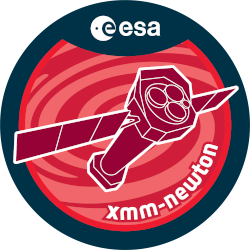

| Proposal ID | 040534 |
| Title | 3C 234: a Compton-thick radio-loud Type 2 quasar in the backyard? |
| Download Data Associated to the proposal | https://nxsa.esac.esa.int/nxsa-sl/servlet/data-action-aio?obsno=0405340101 |
| DOI | https://doi.org/10.5270/esa-dxipftw |
| Principal Investigator, PI | Dr Enrico Piconcelli |
| Abstract | We propose a 30 ks XMM-Newton observation of the hidden radio-loud quasar 3C 234(z = 0.1848). The F(2-10)/F(OIII) ratio and a low signal-to-noise ASCAspectrum strongly suggest the possibility that the nuclear absorber isCompton-thick. The detection of a Fe Kalpha line with EW larger than 1 keV inthe XMM-Newton spectrum would definitely confirm this suggestions. If so, 3C 234would turn out to be the first Compton-thick radio-loud Type 2 QSO observed and,with an intrinsic 2-10 keV luminosity of 3 x 10e46 erg/s, one of the very mostpowerful object ever detected at z less than 0.2. The discovery of an AGN withsuch peculiar properties is strongly needed in the framework of Unified Modelsand, thereby, in the synthesis models of the X-ray cosmic background. |
| Publications |
|
| Instrument | EMOS1, EMOS2, EPN, OM, RGS1, RGS2 |
| Temporal Coverage | 2006-04-24T05:58:49Z/2006-04-24T17:04:10Z |
| Version | 17.56_20190403_1200 |
| Mission Description | The European Space Agencys (ESA) X-ray Multi-Mirror Mission (XMM-Newton) was launched by an Ariane 504 on December 10th 1999. XMM-Newton is ESAs second cornerstone of the Horizon 2000 Science Programme. It carries 3 high throughput X-ray telescopes with an unprecedented effective area, and an optical monitor, the first flown on a X-ray observatory. The large collecting area and ability to make long uninterrupted exposures provide highly sensitive observations. Since Earths atmosphere blocks out all X-rays, only a telescope in space can detect and study celestial X-ray sources. The XMM-Newton mission is helping scientists to solve a number of cosmic mysteries, ranging from the enigmatic black holes to the origins of the Universe itself. Observing time on XMM-Newton is being made available to the scientific community, applying for observational periods on a competitive basis. |
| Creator Contact | https://www.cosmos.esa.int/web/xmm-newton/xmm-newton-helpdesk |
| Date Published | 2008-08-29T00:00:00Z |
| Last Update | 2025-08-04 |
| Keywords | "XMM", "powerful object", "backyard ?.", "3c 234", "XMM-Newton", "compton thick", "xmm newton spectrum", "kev luminosity", "low signal", "xmm newton", "synthesis models", "fe kalpha line", "noise asca spectrum", "nuclear absorber", "unified models", "xray cosmic background", "ew larger", "x 10e46 erg" |
| Publisher And Registrant | European Space Agency |
| Credit Guidelines | European Space Agency, Dr Enrico Piconcelli, 2008, '3C 234: a Compton-thick radio-loud Type 2 quasar in the backyard?', 17.56_20190403_1200, European Space Agency, https://doi.org/10.5270/esa-dxipftw |